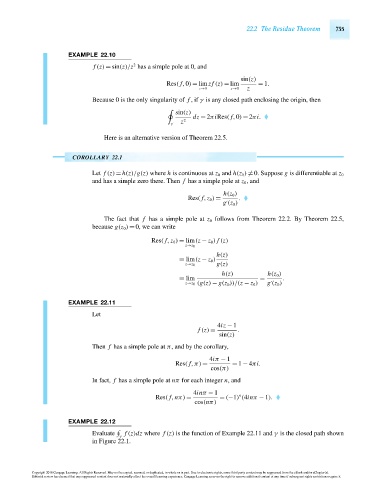Page 755 - Advanced_Engineering_Mathematics o'neil
P. 755
22.2 The Residue Theorem 735
EXAMPLE 22.10
2
f (z) = sin(z)/z has a simple pole at 0, and
sin(z)
Res( f,0) = lim zf (z) = lim = 1.
z→0 z→0 z
Because 0 is the only singularity of f ,if γ is any closed path enclosing the origin, then
sin(z)
dz = 2πiRes( f,0) = 2πi.
z 2
γ
Here is an alternative version of Theorem 22.5.
COROLLARY 22.1
Let f (z) = h(z)/g(z) where h is continuous at z 0 and h(z 0 ) = 0. Suppose g is differentiable at z 0
and has a simple zero there. Then f has a simple pole at z 0 , and
h(z 0 )
Res( f, z 0 ) = .
g (z 0 )
The fact that f has a simple pole at z 0 follows from Theorem 22.2. By Theorem 22.5,
because g(z 0 ) = 0, we can write
Res( f, z 0 ) = lim(z − z 0 ) f (z)
z→z 0
h(z)
= lim(z − z 0 )
z→z 0 g(z)
h(z) h(z 0 )
= lim = .
z→z 0 (g(z) − g(z 0 ))/(z − z 0 ) g (z 0 )
EXAMPLE 22.11
Let
4iz − 1
f (z) = .
sin(z)
Then f has a simple pole at π, and by the corollary,
4iπ − 1
Res( f,π) = = 1 − 4πi.
cos(π)
In fact, f has a simple pole at nπ for each integer n, and
4inπ − 1
n
Res( f,nπ) = = (−1) (4inπ − 1).
cos(nπ)
EXAMPLE 22.12
Evaluate f (z)dz where f (z) is the function of Example 22.11 and γ is the closed path shown
γ
in Figure 22.1.
Copyright 2010 Cengage Learning. All Rights Reserved. May not be copied, scanned, or duplicated, in whole or in part. Due to electronic rights, some third party content may be suppressed from the eBook and/or eChapter(s).
Editorial review has deemed that any suppressed content does not materially affect the overall learning experience. Cengage Learning reserves the right to remove additional content at any time if subsequent rights restrictions require it.
October 14, 2010 15:37 THM/NEIL Page-735 27410_22_ch22_p729-750

